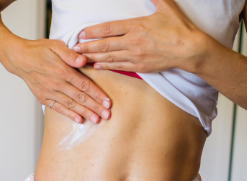Inverse Psoriasis: Everything you need to know!
Published 29 Oct 2023 • By Somya Pokharna
Inverse psoriasis is a unique form of psoriasis that primarily affects skin folds, such as the armpits, groin, beneath the breasts, and genital area. Unlike the more common plaque psoriasis, which manifests as thick, scaly patches on external skin surfaces, inverse psoriasis is characterized by the smooth, discolored rash-like patches that are often accompanied by itching and discomfort.
So, what are the symptoms of inverse psoriasis? What is it caused by? And how can it be effectively managed?
Uncover the answers in this article!

What is inverse psoriasis? What are its signs and symptoms?
Inverse psoriasis, also known as hidden, intertriginous, or flexural psoriasis, is a distinct type of psoriasis that primarily affects skin folds, including the armpits, groin, beneath the breasts, and in the genital area. This condition leads to the rapid reproduction of skin cells, resulting in smooth, shiny, and discolored rash-like patches, often accompanied by itching and discomfort. Inverse psoriasis is prevalent in individuals with deep skin folds and may present differently in those with darker skin, typically resulting in darker lesions, in contrast to the brighter red lesions commonly observed in individuals with Caucasian skin.
Unlike plaque psoriasis, which typically manifests on external skin surfaces such as the knees and knuckles, forming thick, discolored patches covered with white or silvery scales, inverse psoriasis lacks these scales due to the warm, moisture-rich environment in skin folds. The affected skin can become notably thicker and may feel tender or sensitive to touch.
Itching is a common symptom, ranging from mild discomfort to severe irritation. Due to its location, managing inverse psoriasis can be challenging, as skin-to-skin friction, moisture, and warmth in skin folds can further worsen the condition, potentially leading to issues such as irritation, skin cracking (fissures), and an increased risk of fungal or bacterial infections.
Inverse psoriasis is non-contagious but often coexists with other forms of psoriasis, making its management and treatment a unique challenge. In contrast to plaque psoriasis, inverse psoriasis is relatively less widespread, impacting around 21% to 30% of individuals dealing with psoriasis.
What causes inverse psoriasis?
Inverse psoriasis is categorized as an immune-mediated disease, suggesting an association with the immune system response. This exaggerated immune reaction leads to inflammation and an accelerated production of new skin cells, called keratinocytes.
Under normal circumstances, the skin regenerates approximately every 28 to 30 days. However, individuals affected by inverse psoriasis experience a significantly faster skin cell turnover. These new cells grow rapidly, move through the skin’s layers, and break through the epidermal barrier every three to four days, causing the characteristic shiny rashes associated with the condition.
While the exact cause still remains unknown, inverse psoriasis, like other forms of psoriasis, is believed to come from a combination of genetic and environmental factors.
What triggers inverse psoriasis flare-ups?
Common triggers for inverse psoriasis include:
- Stress
- Tobacco or alcohol use
- Skin injuries
- Infections (especially Streptococcal infections and upper respiratory tract infections)
- Friction in deep skin folds
- Certain medications like beta-blockers, lithium, and antimalarial drugs
- Skin trauma, including sunburns, cuts, and abrasion (known as the Koebner phenomenon)
- Obesity
How is inverse psoriasis treated?
While there is no cure for inverse psoriasis, many treatment options exist to provide relief from symptoms and maintain the condition. Healthcare providers might prescribe the following:
Calcipotriol Skin Ointment
This ointment contains calcipotriol, a form of vitamin D3 known for its ability to slow skin cell turnover and reduce discoloration in affected areas, offering relief for individuals dealing with inverse psoriasis. However, it can irritate the skin and must be used carefully.
Corticosteroid Creams or Ointments
Corticosteroid creams or ointments may be prescribed to combat inflammation associated with inverse psoriasis, helping to alleviate discomfort and symptoms. These topical medications suppress the immune system to reduce inflammation, but also can cause thinning of the skin and must be used carefully on the already-thin skin located in skin folds.
Injectable Biologic Medicines
Biologic medicines are made from living cells and target specific parts of the immune system that play a role in psoriasis. In severe cases, medication may be administered via a hypodermic needle, either under the skin or directly into a vein. Examples of such injectable medicines include adalimumab, etanercept, and infliximab, offering targeted treatment for more challenging cases of inverse psoriasis.
Oral Medicines
For severe forms of inverse psoriasis, oral medicines in the form of pills or capsules may be taken by mouth. These can include acitretin capsules, apremilast oral tablets, cyclosporine pills, and methotrexate tablets, providing systemic relief for the condition.
Tacrolimus ointment and Pimecrolimus cream
While tacrolimus ointment and pimecrolimus cream are typically used to treat eczema, they may also be beneficial in managing inverse psoriasis, offering an alternative approach to alleviate symptoms and discomfort. However, the FDA cautions people to use these medicines only for a short time, since some studies suggest they may be linked to a slight risk of cancer.
Light Therapy
Light therapy, also known as phototherapy, involves exposing the affected skin and lesions to ultraviolet light, often ultraviolet B (UVB), emitted by special lamps. This treatment harnesses the therapeutic potential of UVB light waves, like those found in sunlight, to address various skin disorders, including inverse psoriasis.
Steroid-free Topical Medications
Roflumilast and tapinarof creams are safe to use long-term, since they suppress the immune system and reduce inflammation without thinning skin.
Coal Tar
This soothing agent is a byproduct of coal processing and comes in gels or ointments that can be applied to lesions. It is also available as a liquid that can be added to bathwater to help relieve symptoms. However, coal tar may irritate the skin and cause redness and dryness.
Castellani’s Paint
Castellani's Paint, containing phenol as its active ingredient, is a liquid applied to help dry out moist psoriasis lesions in skin folds.
Please note that it is imperative to seek guidance from your healthcare provider before initiating any new medication or making changes to your current medication regimen.
How can inverse psoriasis be managed at home?
Managing inverse psoriasis at home is crucial for alleviating symptoms, although it's essential to consult a healthcare professional before attempting these remedies due to potential allergic reactions. Here are steps to consider:
Bathing and Shower Practices
Opt for lukewarm water over hot, keep bathing sessions under 15 minutes, and make it a daily practice. Avoid abrasive scrubs and washcloths, instead opting for gentle cleansing using your hands and fragrance-free soap. After the bath or shower, take care to gently blot your skin dry with a towel. These measures will help minimize skin irritation.
Moisturize
Apply fragrance-free moisturizer to affected areas within 5 minutes of bathing or when your skin feels dry or irritated.
Clothing Choices
Wear loose-fitting clothing to reduce friction and skin irritation, and switch to cotton underwear to absorb moisture.
Dietary Considerations
Incorporate fiber-rich foods in your diet, particularly if the genital or buttocks area is affected, to ease bowel movements and reduce skin irritation.
Natural Treatments
Discuss natural treatments with your doctor, including herbal therapies like Mahonia aquifolium (Oregon grape), aloe vera, and others that may help alleviate symptoms.
Healthy Lifestyle
Adopt a healthy lifestyle by maintaining a balanced diet, reducing processed foods, and engaging in regular exercise to manage psoriasis symptoms and potentially make treatments more effective.
Mind-Body Interventions
Explore stress-reduction practices such as aromatherapy, meditation, and mindfulness to address stress triggers linked to psoriasis.
Incorporating these home remedies and lifestyle changes can be valuable for managing inverse psoriasis and reducing discomfort.
Key Takeaways
Inverse psoriasis is a unique form of the condition that primarily affects skin folds, resulting in smooth, shiny, and discolored patches accompanied by itching. The triggers for flare-ups can vary and may include stress, skin injuries, infections, and certain medications.
While there is no cure, numerous treatments, both medical and natural, can provide relief and manage the symptoms of this condition. Medical treatments include calcipotriol ointment, corticosteroid creams, injectable biologics, oral medications, and light therapy. Additionally, bathing practices, clothing choices, and dietary considerations can be particularly useful for managing inverse psoriasis at home. However, it is vital to always consult a healthcare provider before introducing any new treatments or lifestyle changes to ensure their safety and suitability.
These strategies offer individuals living with inverse psoriasis the opportunity to alleviate symptoms, reduce discomfort, and improve their overall quality of life.
Give it a "Like" and share your thoughts and questions with the community in the comments below!
Take care!
Sources:
How Do You Manage Inverse Psoriasis? MedicineNet
Inverse psoriasis: Causes, symptoms, and more, Medical News Today
Inverse Psoriasis: From Diagnosis to Current Treatment Options, NIH.gov
Inverse Psoriasis: National Psoriasis Foundation, Psoriasis.org
Inverse Psoriasis: What It Is, Treatment, Groin & Armpit, Cleveland Clinic
Treatment of Inverse/Intertriginous Psoriasis: Updated Guidelines from the Medical Board of the National Psoriasis Foundation, Journal of Drugs in Dermatology

 Facebook
Facebook Twitter
Twitter



